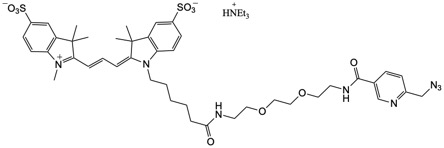Click chemistry describes a class of chemical reactions that use bio-orthogonal or biologically unique moieties to label and detect a molecule of interest in mild, aqueous conditions. The click reaction involves a copper-catalyzed triazole formation from an azide and an alkyne. The azide and alkyne moieties can be used interchangeably; either one can be used to tag the molecule of interest, while the other is used for subsequent detection.
Picolyl azide is a functionalized organic azide derivative that incorporates a picolyl group (a pyridine ring attached to a methylene group) which can chelate copper ions, enhancing the rate and efficiency of copper-catalyzed azide-alkyne cycloaddition (CuAAC) reactions.
The Cy3 picolyl azide is reactive with terminal alkyne via a copper-catalyzed click reaction at a much lower copper (I) concentration without sacrificing reaction efficiency, which protects against undesired copper side reactions with proteins (e.g., GFP, RPE), nucleic acids (e.g., RNA, oligos), and even small molecules (e.g., phalloidin).
Reference
Features

Figure 1. Click chemistry labeling
Specifications
Label:
Cy3

Ex/Em:
555/565 nm
Detection Method:
Fluorescent
Solubility:
DMSO, DMF
Product Size:
0.5 µmol
Storage Conditions:
-20 ℃, protect from light
Shipping Condition:
Room Temperature
Applications
Bioconjugation, biomolecular labeling, live-cell imaging, and flow cytometry.
Datasheet (PDF):
C344
MSDS (PDF):
C344
Angew Chem Int Ed Engl (2012) 51:3143-3146
Nucleic Acids Res (2012) 40:e78-e78
Proc Natl Acad Sci U S A (2013) 110:4992-4997
Proc Natl Acad Sci U S A (2007) 104:2614-2619
Angew Chem Int Ed Engl (2009) 48:4030-4033
Related Products
Home » Click Chemistry Tools » Cy3 Picolyl Azide
Cy3 Picolyl Azide
Introduction
To order
Documents
Dumont A, Malleron A, Awwad M, Dukan S, Vauzeilles B,
Winz ML, Samanta A, Benzinger D, Jäschke A,
Ngo JT, Schuman EM, Tirrell DA,
Hsu TL, Hanson SR, Kishikawa K, Wang SK, Sawa M, Wong CH
Chang PV, Chen X, Smyrniotis C, Xenakis A, Hu T, Bertozzi CR, Wu P
Related products
Contact Us
ABP Biosciences
405 E Gude Dr, STE 214
Rockville, MD 20850
Service Hotline
Tel: 301-658-7993
E-mail: info@abpbio.com
Copyright@ 2025 ABP Biosciences, LLC. All Rights Reserved.

